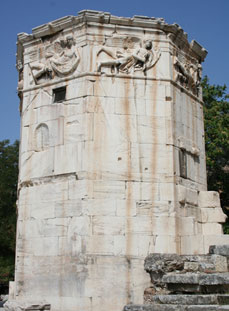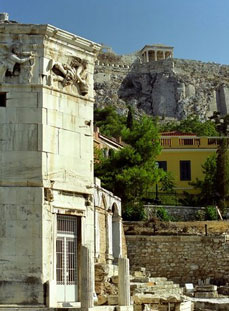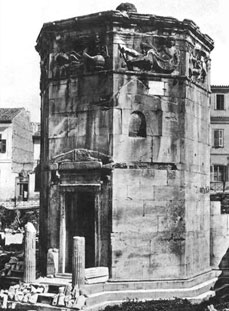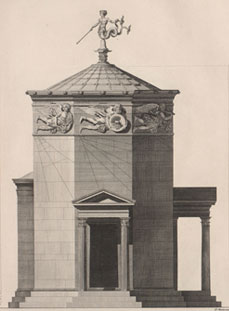



Athens Tower of the Winds
Most scholars believe that the horologeion (water clock) was built as a public sundial, water clock and weathervane by the astronomer Andronikos Kyrrhestas c. 50/40 BC (as it was mentioned in Varro's De Re Rustica which was published in 37 BC and Vitruvius discusses it as well). On the other hand, the archaeologist Herman Kienast (German Archaeological Institute at Athens) has revived the suggestion that it was built before the Roman general Sulla's sack of the city in 86 BC. As the letter forms of the inscriptions identifying the winds are very similar to those on the dedication of the Stoa of Attalos, built c. 158-138 BC in the Agora, the horologeion may date to the late 2nd century BC. It is possible that the repairs which were made to the structure date to the period after 30 BC based on an inscription which mentions an Oilier Kyrrhistou (House of Kyrrhestas).
During the earlier Empire the horologeion was located on the west side of a large open forum-like plaza, 100 x 50 m, with a public latrine building, the so-called Agoranomeion and the Pantheon. The structure has an octagonal plan, 3.2 m on each side, and is built entirely of white Pentelic marble. It once had two simple porches formed by two Corinthian columns and a pediment (on the northeast and the northwest faces). There is a circular water reservoir on the south face. According to Vitruvius, the pyramidal roof was crowned originally by a gilded bronze Triton holding a wand, which served as a weathervane to indicate the prevailing wind. Each face marks a cardinal point and has an inscribed sundial, as well as a male personification of one of the winds in relief (with his named inscribed) at the top. North (facing Aeolou str.): a bearded old Voreas (blowing the cold, north winds of the winter from a conch shell). Northwest: a bearded Skiron (scattering glowing ashes from an inverted bronze brazier, indicating the warmer winter winds). West: the partially clothed youth Zephyros (scattering flowers from his lap, symbolizing the mild winds). Southwest: lightly dressed Lips (holding the aphlaston or the steering rudder of a ship, to speed sailors on their way). South: the youth Notos dressed in a chlamys (bringing rain by emptying an amphora filled with water). Southeast: bearded old man Euros (wearing a cloak bringing violent storms in the winter and early spring). East: the lightly dressed youth Apeliotes (bearing fruits and wheat in his cloak, symbolizing the warmth and rain these winds bring in the spring. Northeast: bearded old man Kaikias (emptying a shield full of hailstones, indicating the violent storms associated with this wind).
Inside the tower there was an elaborate mechanism with a reservoir, pipes and channels for a now lost 24 hour waterclock (clepsydra). There are three types of cuttings in the floor: I) grooves in which the water pipes were laid; 2) curving grooves for a parapet; and 3) beddings for the waterclock and three statues. Originally, water pipes in the floor fed into the clock from underground pipes. In a second phase, water would have reached the container in the round annexe by means of an aqueduct above ground. According to Keinast this water source was possibly a spring on the northern slopes of the Akropolis, that reached the round annexe, on top of the arcaded structure commonly called the Agoranomeion. The time was read by looking from the northwest door at the water level in a cylinder inside the tower.
There is no other building comparable to this in Greek architecture, as it is unique in design and structural idiosyncrasies. It is interesting to note here that Pausanias makes no mention of the tower. The octagonal plan is essentially the one that Vitruvius describes for designing a wind rose. If the horologeion predates 86 BC, some scholars see it as a dedication in the 2nd century BC by one of the Hellenistic territorial monarchs who were seeking Athenian support in their ongoing battles with the other Greek kings for control of the Aegean. Kienast believes, however, that as this building was built in an open space on high ground with no relationship to any other structure, its only purpose was to give pleasure and pride to the Athenians. Thus, he sees it as the donation of a private patron. R.E. Wycherley has suggested the astronomer Andronikos Kyrrhestas as this patron. The dedicatory inscription would have been carved on the exterior wall of round annexe.
In the Early Byzantine period it was used as a Christian baptistery. While in the Medieval period people thought the structure was once the school or prison of Socrates. The first European traveler to mention this building was Cyriacus of Ancona, who described it in 1436 as the Temple of Aeolos, the god of the winds. In the 17th century the Turkish traveler Evliya Chelebi was told by local informants that it was the Tent of Plato where King Philip II of Macedon was buried. During the Ottoman period a group of Mevlevi dervishes (a Muslim order of ascetics founded in Konya southern part of modern Turkey, in the 13th-century by the Sufi Poet Melvana Celaddin Rumi) used the structure as a tekke (ceremonial hall, lodge or monastery). Hence, it was called the Tekke tou Braimi, for their chants and whirling trance-like dance, called a sema, every Friday after midday prayers. Its use as a mosque is indicated by the mihrab visible in the plastered middle zone in the southeastern section. The dance was a popular local attraction for those Europeans doing the Grand Tour in the 18th and early 19th centuries. The neighborhood in the immediate vicinity of the Tower is called Aerides after the carved figures on the monument's faces.
